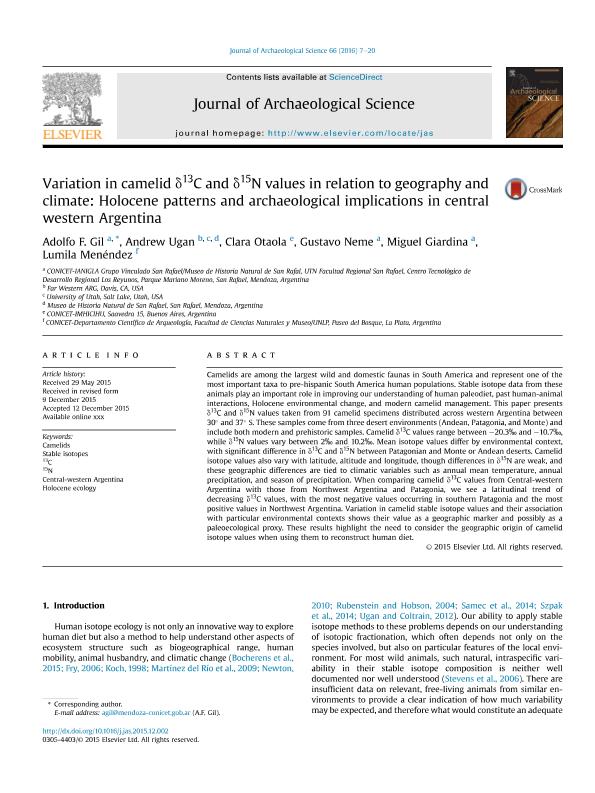Mostrar el registro sencillo del ítem
dc.contributor.author
Gil, Adolfo Fabian

dc.contributor.author
Ugan, Andrew
dc.contributor.author
Otaola, Clara

dc.contributor.author
Neme, Gustavo Adolfo

dc.contributor.author
Giardina, Miguel Angel

dc.contributor.author
Menendez, Lumila Paula

dc.date.available
2018-03-15T17:05:54Z
dc.date.issued
2016-02
dc.identifier.citation
Gil, Adolfo Fabian; Ugan, Andrew; Otaola, Clara; Neme, Gustavo Adolfo; Giardina, Miguel Angel; et al.; Variation in camelid δ13C and δ15N values in relation to geography and climate: Holocene patterns and archaeological implications in central western Argentina; Academic Press Ltd - Elsevier Science Ltd; Journal of Archaeological Science; 66; 2-2016; 7-20
dc.identifier.issn
0305-4403
dc.identifier.uri
http://hdl.handle.net/11336/38909
dc.description.abstract
Camelids are among the largest wild and domestic faunas in South America and represent one of the most important taxa to pre-hispanic South America human populations. Stable isotope data from these animals play an important role in improving our understanding of human paleodiet, past human-animal interactions, Holocene environmental change, and modern camelid management. This paper presents δ13C and δ15N values taken from 91 camelid specimens distributed across western Argentina between 30° and 37° S. These samples come from three desert environments (Andean, Patagonia, and Monte) and include both modern and prehistoric samples. Camelid δ13C values range between -20.3‰ and -10.7‰, while δ15N values vary between 2‰ and 10.2‰. Mean isotope values differ by environmental context, with significant difference in δ13C and δ15N between Patagonian and Monte or Andean deserts. Camelid isotope values also vary with latitude, altitude and longitude, though differences in δ15N are weak, and these geographic differences are tied to climatic variables such as annual mean temperature, annual precipitation, and season of precipitation. When comparing camelid δ13C values from Central-western Argentina with those from Northwest Argentina and Patagonia, we see a latitudinal trend of decreasing δ13C values, with the most negative values occurring in southern Patagonia and the most positive values in Northwest Argentina. Variation in camelid stable isotope values and their association with particular environmental contexts shows their value as a geographic marker and possibly as a paleoecological proxy. These results highlight the need to consider the geographic origin of camelid isotope values when using them to reconstruct human diet.
dc.format
application/pdf
dc.language.iso
eng
dc.publisher
Academic Press Ltd - Elsevier Science Ltd

dc.rights
info:eu-repo/semantics/openAccess
dc.rights.uri
https://creativecommons.org/licenses/by-nc-nd/2.5/ar/
dc.subject
13c
dc.subject
15n
dc.subject
Camelids
dc.subject
Central-Western Argentina
dc.subject
Holocene Ecology
dc.subject
Stable Isotopes
dc.subject.classification
Historia

dc.subject.classification
Historia y Arqueología

dc.subject.classification
HUMANIDADES

dc.title
Variation in camelid δ13C and δ15N values in relation to geography and climate: Holocene patterns and archaeological implications in central western Argentina
dc.type
info:eu-repo/semantics/article
dc.type
info:ar-repo/semantics/artículo
dc.type
info:eu-repo/semantics/publishedVersion
dc.date.updated
2018-03-12T18:15:52Z
dc.journal.volume
66
dc.journal.pagination
7-20
dc.journal.pais
Estados Unidos

dc.description.fil
Fil: Gil, Adolfo Fabian. Consejo Nacional de Investigaciones Científicas y Técnicas. Centro Científico Tecnológico Conicet - Mendoza. Instituto Argentino de Nivología, Glaciología y Ciencias Ambientales. Museo de Historia Natural de San Rafael - Ianigla | Provincia de Mendoza. Instituto Argentino de Nivología, Glaciología y Ciencias Ambientales. Museo de Historia Natural de San Rafael - Ianigla | Universidad Nacional de Cuyo. Instituto Argentino de Nivología, Glaciología y Ciencias Ambientales. Museo de Historia Natural de San Rafael - Ianigla; Argentina
dc.description.fil
Fil: Ugan, Andrew. University of Utah; Estados Unidos. Museo Municipal de Historia Natural San Rafael - Unidad Asociada al CCT Mendoza; Argentina
dc.description.fil
Fil: Otaola, Clara. Consejo Nacional de Investigaciones Científicas y Técnicas. Oficina de Coordinación Administrativa Saavedra 15. Instituto Multidisciplinario de Historia y Ciencias Humanas; Argentina
dc.description.fil
Fil: Neme, Gustavo Adolfo. Consejo Nacional de Investigaciones Científicas y Técnicas. Centro Científico Tecnológico Conicet - Mendoza. Instituto Argentino de Nivología, Glaciología y Ciencias Ambientales. Museo de Historia Natural de San Rafael - Ianigla | Provincia de Mendoza. Instituto Argentino de Nivología, Glaciología y Ciencias Ambientales. Museo de Historia Natural de San Rafael - Ianigla | Universidad Nacional de Cuyo. Instituto Argentino de Nivología, Glaciología y Ciencias Ambientales. Museo de Historia Natural de San Rafael - Ianigla; Argentina
dc.description.fil
Fil: Giardina, Miguel Angel. Consejo Nacional de Investigaciones Científicas y Técnicas. Centro Científico Tecnológico Conicet - Mendoza. Instituto Argentino de Nivología, Glaciología y Ciencias Ambientales. Museo de Historia Natural de San Rafael - Ianigla | Provincia de Mendoza. Instituto Argentino de Nivología, Glaciología y Ciencias Ambientales. Museo de Historia Natural de San Rafael - Ianigla | Universidad Nacional de Cuyo. Instituto Argentino de Nivología, Glaciología y Ciencias Ambientales. Museo de Historia Natural de San Rafael - Ianigla; Argentina
dc.description.fil
Fil: Menendez, Lumila Paula. Universidad Nacional de La Plata. Facultad de Ciencias Naturales y Museo. Departamento Científico de Arqueología; Argentina. Consejo Nacional de Investigaciones Científicas y Técnicas; Argentina
dc.journal.title
Journal of Archaeological Science

dc.relation.alternativeid
info:eu-repo/semantics/altIdentifier/url/http://www.sciencedirect.com/science/article/pii/S0305440315003179
dc.relation.alternativeid
info:eu-repo/semantics/altIdentifier/doi/http://dx.doi.org/10.1016/j.jas.2015.12.002
Archivos asociados
